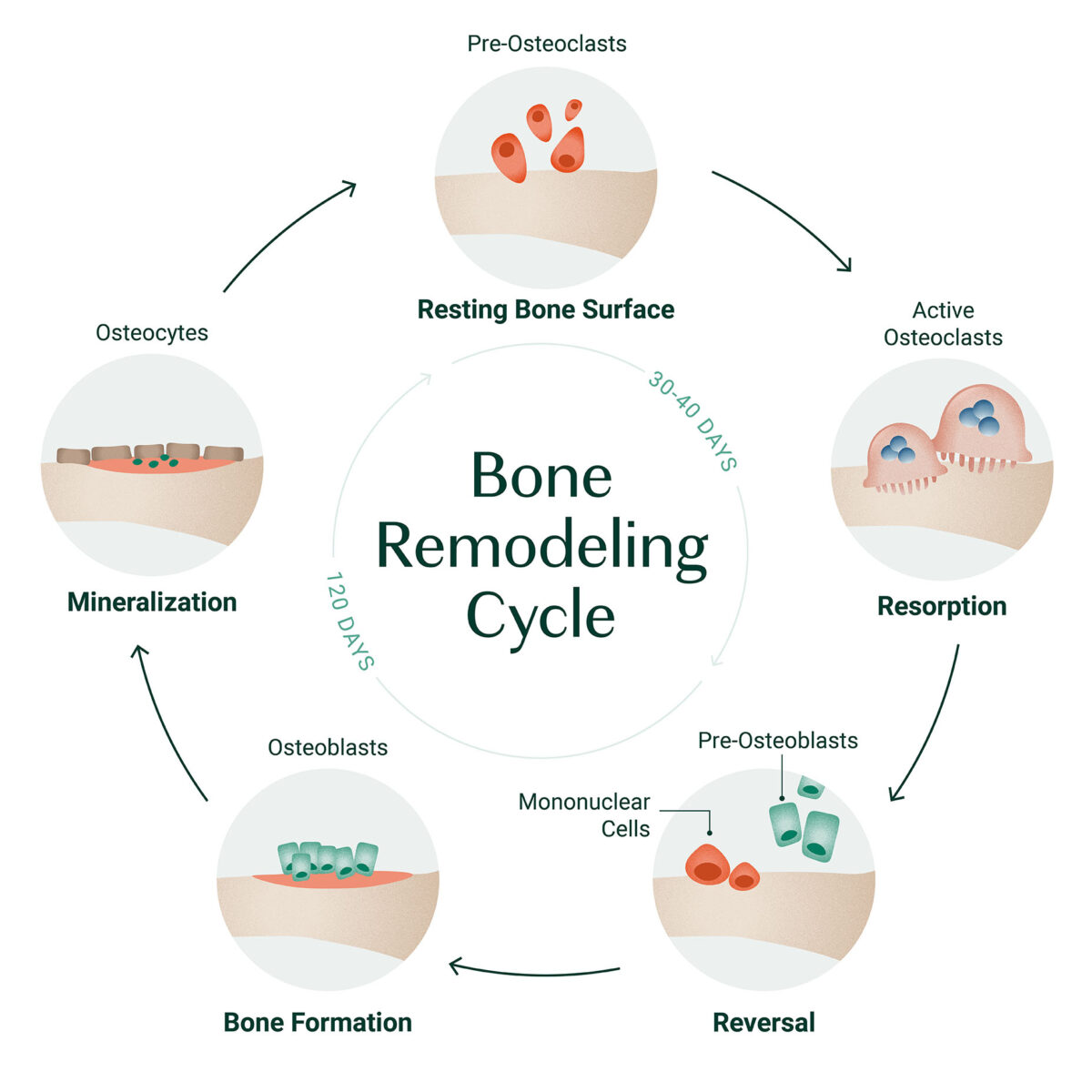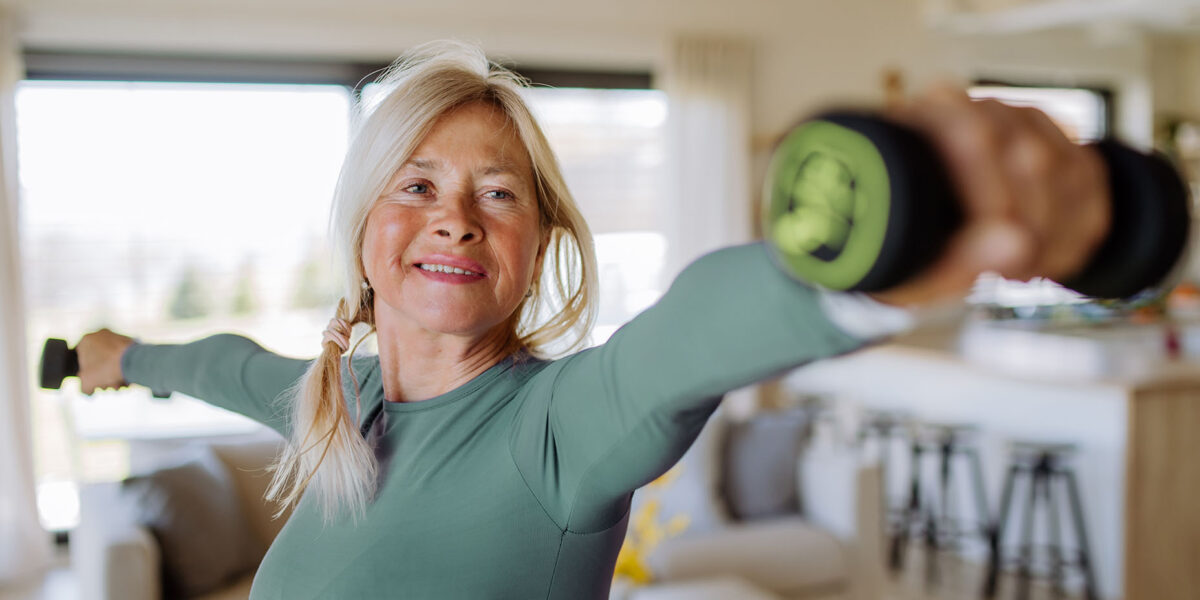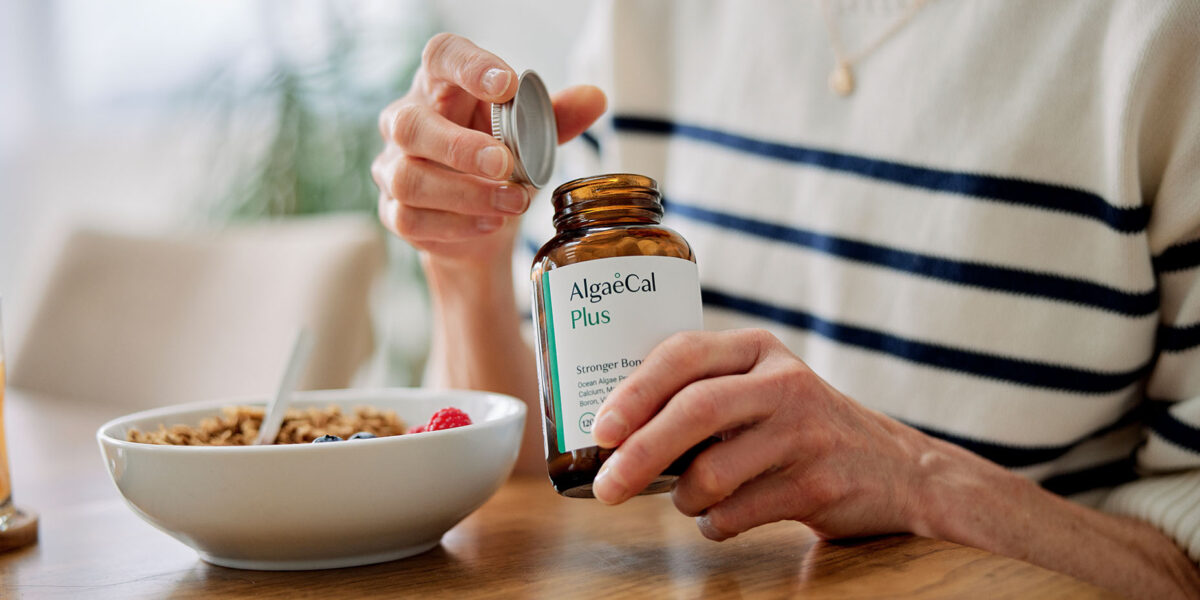Several risk factors can set the stage for osteoporosis, but if you have a family member with this condition, you need to be on extra high alert. Why? Studies show that osteoporosis has a genetic component, which means that if people in your family have osteoporosis you’re at a much higher risk yourself.
The good news is that even if your family is predisposed to brittle bones, you can get ahead of potential harm if you know what steps to take.
Let’s dive into the current research and science so that you can properly take care of yourself and your family. With these tips you’ll be able to prepare for any complications that may arise in the future.
How Does Osteoporosis Develop?
In the simplest terms, osteoporosis is the result of an imbalance between bone building and bone breakdown. This process, called bone remodeling, requires a delicate dance involving two types of cells; osteoclasts and osteoblasts [1].

While osteoclasts break down bone (bone resorption), osteoblasts come in to rebuild bone. The process of bone remodeling happens all of the time, and in healthy bones, the rate of breakdown matches the rate of rebuilding. This allows for a continuous turnover of fresh, healthy bone material.
In the case of osteoporosis, osteoclast activity outpaces osteoblasts, resulting in loss of bone density. This creates bones that are weak and brittle and more prone to break.
But what triggers this imbalance in the first place? Well, that’s where things get a bit more complicated.
One well-researched cause of osteoporosis is hormonal imbalances that come with aging, specifically in postmenopausal women. This is due to estrogen’s role in the bone remodeling process, with low estrogen levels causing enhanced bone resorption without adequate rebuilding [2].
That said, men certainly aren’t in the clear when it comes to osteoporosis. In addition to low testosterone in men, there are a handful of other non-hormone-related causes that can impact bone health in both sexes.
Additional risk factors for osteoporosis include:
- Nutrient deficiencies
- Toxic exposure
- Lack of physical activity
- Cigarette smoking
- Certain medications
- Genetics
The Genetic Component Of Osteoporosis
Although researchers are still uncovering the exact link between genetics and osteoporosis, several studies support the fact that this condition has a strong genetic component to it.
For example, studies conducted on intergenerational families show a heritability of bone mineral density of 44% to 67% [3]. And that number shoots up to 46% to 92% in twin studies [4].
Furthermore, in a 2018 study, researchers identified 899 regions in the human genome associated with low bone mineral density [5].
While the exact genetic mechanisms are still being studied, scientists generally agree that it’s likely a combination of factors that sets the genetic stage for osteoporosis. Some potential explanations include:
- Genes impacting bone repair. Certain genes influence a pathway known as the Wnt signaling pathway. When active, Wnt signaling allows for the secretion of proteins that help to regulate and maintain fracture repair, skeletal development, and bone mass. When the genes involved in this pathway aren’t functioning properly, it can inhibit osteoblast activity and, therefore, the development of new bone [6].
- Genes interfering with osteoclast function. Another pathway that may relate to the genetic component of osteoporosis is the RANK-RANKL-OPG pathway. This process is crucial for the activation, recruitment, and differentiation of osteoclast cells, which play a vital role in bone turnover [7].
- Genes interfering with the deposition of the bone matrix. The process of mineralizing the bone matrix is called endochondral ossification and is carried out with the help of osteoblast cells. Studies show the potential of genetic variants to interfere with several aspects of this process, including the development of cartilage, osteoblast differentiation, and cartilage ossification [8].
From what we know so far, it appears that in addition to direct genetic influence, epigenetics also play a role in the development of osteoporosis [9]. In other words, you may be genetically predisposed to osteoporosis, but your environment and lifestyle can influence whether or not this condition develops [10].
This is great news if you’re someone with a strong genetic predisposition to brittle bones – it means that your genes are not your destiny. So let’s look at some preventative strategies to keep your bones strong and healthy.
Preventative Tips For Getting Ahead of Osteoporosis
There are several known strategies for getting ahead of osteoporosis. In fact, we have an entire post that details the steps you can take, which you can check out here. But for a brief overview, here are some of the most effective tips for preventing osteoporosis.
Consume a Bone-Building Diet
Your diet provides you with the building blocks for healthy bones. Several nutrients go into the bone-building and maintenance process, which means that a varied diet full of high-quality foods and optimal amounts of protein is key. As much as possible, try to consume a diet that consists of whole, real foods, and avoid processed foods that are high in sugar and additives (and other inflammatory ingredients).
Keep an Eye on Your Hormone Levels
As mentioned, hormones play a significant role in bone health, especially as you age. Regularly checking your hormone levels to ensure that you’re on track with your age and sex is essential to staying ahead of potential risks like osteoporosis.
Make Weight-Bearing Exercise a Habit
Weight-bearing exercise is one of the most efficient ways to promote bone mineral density. When you put a strain on your muscles, it directly impacts bone strength and integrity. Adding in some weight-bearing exercise a few times a week can make a world of difference in the health of your bones [11].

Watch Your Sleep and Your Stress
Both poor sleep and high stress have been found to correlate with poor bone health. Unfortunately, stress and poor sleep often go hand-in-hand. The good news is, reducing your stress often enhances sleep quality, and vice versa [12][13].
If you’re feeling overwhelmed or are finding yourself tossing and turning at night, make it a priority to tackle these issues.
Take Bone-Building Supplements
Diet is crucial for healthy bones, but the sad truth is that our soils today are depleted and it’s hard to get enough of the nutrients we need to build and maintain healthy bones. Add to this the fact that we naturally start losing bone mineral density in our early 30s, and by the time you reach middle age your bones are starving for nutrition.
Supplements that contain a balance of calcium, vitamin D3, and vitamin K are crucial. While calcium directly supports the density and strength of your bones, vitamin D3 helps your body absorb this crucial mineral, and vitamin K makes sure it gets shuttled to your bones, instead of depositing in your heart or other tissues where it doesn’t belong.

AlgaeCal Plus was formulated with science-backed ratios of each of these nutrients in their most bioavailable forms, along with several other vitamins and minerals that support the integrity of your bones. And for a more simple formula, AlgaeCal Basic provides our tried-and-true algae-based calcium along with vitamin D3 to ensure your body is absorbing as much calcium as possible.
Takeaway
While scientists work to uncover the exact genetic mechanisms behind osteoporosis, you can rest assured that even if you’re genetically predisposed, there’s plenty you can do to get ahead of weak, brittle bones in your future.
Osteoporosis is a condition that is often the result of several factors, including age, diet, sex, and a myriad of lifestyle factors. Ultimately, the power to keep your bones healthy and strong is in your hands.
To stay on top of all things bone-health, sign up for the AlgaeCal Newsletter for frequent hits of inspiration and education.
FAQs
At what age does osteoporosis typically start?
Osteoporosis typically starts around the age of 50. Peak bone mass is usually reached around your late 20s or early 30s, after which time bone mineral density can slowly begin to decrease as bone remodeling outpaces bone building. With that said, most people won’t experience osteoporosis until they reach age 50 or older.
What percent of osteoporosis is genetic?
While we know that there is a genetic component to osteoporosis, the exact mechanism and prevalence of inherited osteoporosis is unclear. That said, some studies suggest osteoporosis could be somewhere between 25-85% genetic.
What are the early warning signs of osteoporosis?
Osteoporosis doesn’t typically have many warning signs in the early stages. However, once bones begin to weaken, you may notice a loss in height, back pain, and a stooped posture.
Can osteoporosis run in the family?
Yes, osteoporosis can run in the family. Having a family member with osteoporosis puts you at greater risk yourself due to the genetic component of this condition.





mary mckinnie
October 28, 2023 , 12:22 amMy very first bone density test was several months ago. The evidence of it stated that I had osteoporosis in my lower lumbar (My back). I’ve been reading and reading different articles, labels, etc! I am plant bases and searching for something organic. Thank you for your help!